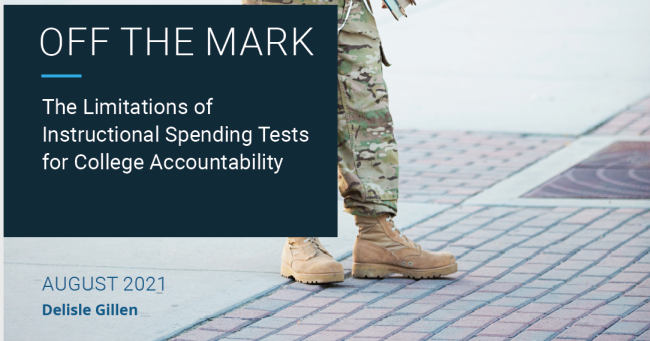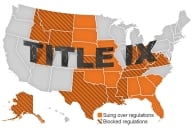You have /5 articles left.
Sign up for a free account or log in.

The report argues that veterans would be especially disadvantaged by a policy that sanctions nontraditional institutions.
Veterans Education Project
A policy proposal floated by a Democratic senator and several think tanks to hold colleges and universities accountable for the value of the education they provide students would unfairly disadvantage nontraditional institutions, argues a recent report by the Veterans Education Project. But proponents of the policy say the report misinterprets what its use would be in practice.
The policy discussed in the report -- and published by Senator Chris Murphy, a Democrat from Connecticut, and organizations like Third Way and the Century Foundation -- would measure how much of an institution’s tuition dollars are used for instructional spending, so that those with poor student outcomes are judged on how they are using their resources. That way, colleges that can’t improve their student outcomes due to a lack of resources aren’t penalized.
The report examines this spending-to-tuition ratio as a way to measure the quality of an institution in conjunction with its student outcomes and penalize the institution for not meeting certain standards. The authors, Andrew Gillen and Jason Delisle, base their analysis on a two-step test for colleges and universities -- where the first step is the institution’s student loan repayment rate and the second is the institution’s instructional spending ratio -- and say the second step creates an exemption for certain institutions to not be sanctioned for poor student outcomes.
“When you do this two-stage test, that second stage basically acts like a get-out-of-jail-free card for a large share of institutions,” Gillen said during a discussion about the report. “If you have weak outcomes but you meet the instructional spending test, you’re off scot-free.”
They examined a total of 3,685 public nonprofit, private nonprofit and for-profit institutions. Their analysis shows that 922 institutions would fail the loan repayment test, but only 166 of those would fail the instructional ratio test -- meaning they spend less than 33 percent of their tuition revenue on instruction -- and would be penalized.
“In other words, including the second stage based on instructional spending allows 82 percent of colleges with low repayment rates to avoid sanctions or qualify for some form of reduced penalties, depending on what the policy prescribes,” the report says.
The report shows that the vast majority of the institutions that would fail both tests are for-profit institutions, while most public nonprofits would not be penalized since they have higher instructional spending ratios. The authors note that because public institutions receive revenue from state and local government sources, they have the ability to use that funding to cover noninstructional costs, while for-profits and private nonprofits have to use tuition revenue to cover both instructional and noninstructional costs.
They also state that the instructional spending category in the Integrated Postsecondary Education Data System -- which is the primary source for colleges’ and universities’ spending data -- may misclassify spending at nontraditional institutions. For online programs, in particular, expenses like course and curriculum designers, support instructors, and interactive learning resources are classified as noninstructional categories, even though they support instructional activities.
“These instructional spending tests are biased towards online -- or basically any alternative -- education model because of the way that instructional spending is measured,” Gillen said. “I’m sure a lot of the people who are advocating for this are doing so in good faith, but it is also concerning to me how this is seeming to narrowly target a very specific type of institution.”
The authors also indicate a “weak correlation between spending and outcomes,” suggesting that an increase in spending ratios wouldn’t lead to better outcomes. But proponents of the instructional spending test say that the way it’s used in the report isn’t actually how it would be used in examining student outcomes.
“The purpose of instructional expenditure policies was never to suggest that they -- either by themselves or in conjunction with outcomes -- would be adequate proxies for quality,” said Barmak Nassirian, vice president for higher education policy at Veterans Education Success. “Quality is much more complicated than that.”
Lanae Erickson, a senior vice president at Third Way, said institutions wouldn’t be let off the hook for poor student outcomes because they have a high instructional spending ratio -- the ratio would only help determine the direction of what should be done to raise those outcomes.
“Instructional spending is not a proxy for outcomes -- it's a diagnosis of why the outcomes are bad,” Erickson said. “All schools should be accountable for their outcomes, but once we figure out it’s not working at a certain school, you have to ask the question, ‘why is that so?’ That’s really the reason for an instructional spending test.”
However, the Veterans Education Project says its research shows that instructional spending as a ratio of tuition also wouldn’t help determine why institutions’ outcomes are bad.
“As we show, 99 percent of public colleges won’t even be dinged by this policy,” said Donald Franklin, director of policy and legislation at the Veterans Education Project. “To put it another way, public institutions will fly under the radar of any potential spending problems because of the way that IPEDS is set up.”
There are many different instructional spending ratio policy proposals, and some of them use different calculations. Erickson cautioned against using one way of calculating it to discredit the proposal altogether.
The report argues that by putting nontraditional colleges at a disadvantage, the policy would limit the options that veterans have available to them, since many veterans and military students prefer to pursue higher education online. But Nassirian said that veterans are at more of a disadvantage if they attend institutions that spend less money on instruction.
“I don’t see how it would put veterans at a disadvantage to redirect them to places that would do a better job of putting resources behind their education,” Nassirian said. “Those places are spending the money on instruction.”








